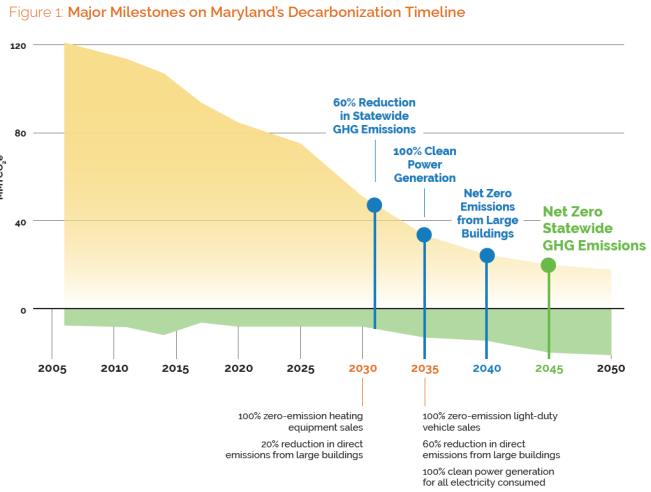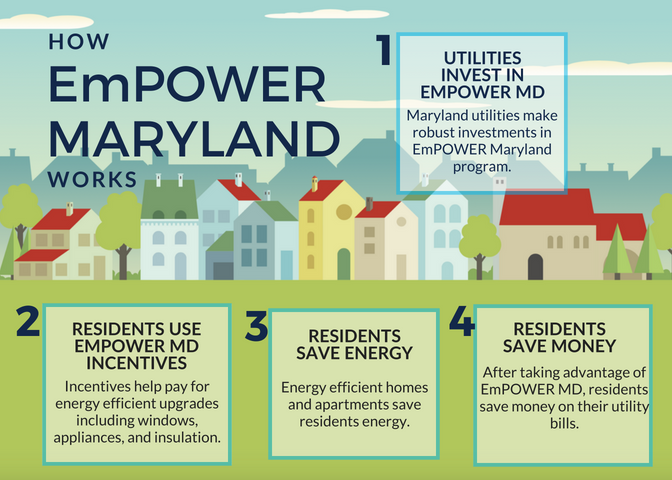

By Luke Miller | Fri, January 31, 25
Energy efficiency programs throughout the Northeast continue to make strides in reducing both energy use and carbon emissions. In a move that continues Maryland’s progress on energy efficiency and decarbonization policies, in December, the Maryland Public Service Commission (PSC) issued an order approving revised EmPOWER Maryland programs from program administrators. As directed by the state legislature in HB 864, these new EmPOWER plans shift Maryland utilities’ goals from energy savings alone to greenhouse gas (GHG) reduction and introduce new beneficial electrification measures that reduce both GHG emissions and energy usage.
The new electrification measures add important strategies for customers, but most savings and emissions reductions will continue to come from energy efficiency measures. In total, these plans are projected to reduce 3.6 million metric tons of lifecycle CO2e emissions from projects completed in 2025 and 2026. Still, more work remains to build out plans further to align programs with the GHG goals.
A Backdrop of Climate Leadership
This approval builds on other steps Maryland has taken over the past few years to reduce GHG emissions across the state. In late 2023, the state released the Climate Pollution Reduction Plan, which describes strategies to accomplish the ambitious goals established in the Climate Solutions Now Act of 2022 (CSNA): reducing emissions by 60 percent from 2006 levels by 2031 and achieving net-zero emissions by 2045.
The CSNA established several policies. It strengthened the state’s energy efficiency resource standard, instituting higher electricity savings goals for utilities (two percent of 2016 sales from 2022-2024; 2.25 percent in 2025, and 2.5 percent in 2026). Additionally, it directed the development of building energy performance standards, the formation of the Climate Catalytic Capital Fund to use efficiency measures to address buildings-sector emissions, and the improvement of utility energy efficiency workforce programs. Similarly, the Climate Pollution Reduction Plan initiated the planning process for two other GHG reduction policies: the clean heat standard and the zero-emission heating equipment standard.
Maryland built on this momentum with the passage of House Bill (HB) 864- An Act Concerning Energy Efficiency and Conservation Plans. This act created new GHG goals for all the EmPOWER utilities. As a result, the PSC required the utilities to file revised program plans for 2025 and 2026 to incorporate the new GHG goals and beneficial electrification measures. Here are three ways the EmPOWER plans have begun to evolve from this new legislation:
- A shift in investment and measures offered to include both energy efficiency and electrification technologies, such as efficient heat pumps, and programs that address barriers to adoption.
- An opportunity for low-income programs in the state offered by the Maryland Department of Housing and Community Development (MD DHCD) to invest in electrification projects for low-income customers.
- A serious look at how the state will address fossil fuel incentives in the current and future cycles given the new policies for both EmPOWER and at the state level.
Focusing EmPOWER Programs on Greenhouse Gas Reductions
Early energy efficiency programs were designed to reduce building energy consumption, but newer generations of these programs have evolved to focus on a broader set of objectives – saving energy and lowering bills, achieving GHG reductions, and serving as a grid resource for reliability and resilience. Achieving GHG reduction goals cost-effectively represents a paradigm shift in energy efficiency program planning from achieving energy savings to achieving both emissions and energy savings. In Maryland, HB864 created GHG reduction goals for the EmPOWER program and required utilities to offer beneficial electrification incentive programs. The legislation defines beneficial electrification as “the replacement of the direct use of fossil fuels in buildings with the use of electricity in a manner that: (1) reduces overall lifetime greenhouse gas emissions; (2) reduces customers’ energy costs; or (3) enables better management of the electric distribution system.”
Through their newly revised plans, the EmPOWER utilities are adding beneficial electrification measures, such as additional incentives for heat pumps, heat pump water heaters and programs to address known barriers to electrification, such as panel, circuitry, and wiring upgrades - into the frameworks of their existing programs. Including additional incentives for beneficial electrification measures is important because the cost of these upgrades has historically been a barrier to electrification.
Now, the EmPOWER utilities are authorized to offer a range of new incentives. For example, up to $3,500 for heat pump water heaters, up to $4,500 for pre-electrification make-ready measures, and up to $15,000 for electrification projects that incorporate air source heat pumps. Additionally, Delmarva Power and Light, Pepco, and Baltimore Gas and Electric (BGE) will offer bonuses to contractors for installing fuel switching measures: up to $200 for each heat pump water heater and up to $500 for each heat pump system installed. BGE’s plan also proposes increasing incentives for fuel switching. BGE’s revised plan includes enhanced incentives for customers that switch from a fossil fuel appliance to a highly efficient electric appliance. For example, BGE’s plan approves funding up to $20,000 for converting a fossil fuel furnace to an air source heat pump (see plans at item numbers 161, 162, 163, 166, 168, and 171).
The new elements added into the revised utility plans provide a concrete example of what types of initiatives states can catalyze to help meet GHG goals.
Improved Low- and Moderate-Income Customer Access to Electrification
In its order approving the revised EmPOWER programs, the PSC also approved the MD DHCD’s request to be able to use a portion of its EmPOWER funding to switch Marylanders from fossil fuels to efficient electric appliances, add an additional incentive (10 percent of measure cost) for electrification measures, and increase the maximum funding amount for multifamily electrification projects. In its order, the PSC noted that allowing MD DHCD to perform electrification projects will greatly increase the GHG emissions savings MD DHCD can achieve, which will help it meet its GHG reduction goal.
This is especially important because DHCD serves low-income customers. These investments can ensure that all communities have access to electrification measures. These changes will improve low- and moderate-income Marylanders’ access to electrification by providing cost-effective options while driving GHG reductions.
The Future of Incentives for New Fossil Fuel Appliances
Another key change in the energy efficiency plans is the discussion concerning incentives for natural gas appliances. Regional peer states such as New York and Massachusetts have introduced provisions that remove or phase out customer-funded incentives for certain new fossil fuel appliances when more efficient and cost-effective electric options exist. Throughout the EmPOWER planning process, several stakeholders expressed interest in a similar pathway to phase out these incentives and shift the funding to whole-house building envelope measures. Advocates noted that subsidizing new fossil fuel-fired appliances, which emit more GHGs than electric heat pumps, works in opposition to the other climate goals of the state, such as upcoming clean heat standard implementation, building energy performance standards, and zero-emission heating equipment standards.
The PSC decided against requiring the removal of gas incentives from the EmPOWER program or introducing a phase-out pathway. However, it’s worth noting that Baltimore Gas and Electric (BGE)’s filed plan removes incentives for equipment that uses natural gas or delivered fossil fuels (plan at item no. 161). The other EmPOWER utilities still offer gas appliance incentives (Southern Maryland Electric Cooperative and Potomac Edison offer them through coordination with Washington Gas). However, the PSC did request that Washington Gas file a version of their EmPOWER plan without gas appliance incentives with their next semi-annual EmPOWER report for cost and emissions comparison purposes.
What’s Next for Maryland?
Now is an important time for states to take innovative climate action in the face of an uncertain federal backdrop. Energy affordability will remain a key priority in Maryland as coal power plants are slated to close in the coming years, and energy efficiency continues to offer the lowest-cost energy resource. The Commission’s order makes progress toward aligning efficiency programs with emissions goals, and more work remains.
Within the last three years, Maryland’s leadership in the passage of the Climate Solutions Now Act, the changes to the EmPOWER program, and the development of related decarbonization policies (its Building Energy Performance Standard and Clean Heat Standard) has kick-started critical climate improvements, shown other states what is possible, and paved the way for additional innovations in the future.



